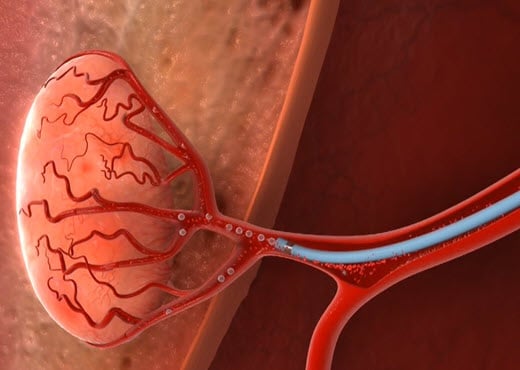Every July, our team at Merit Medical recognizes Fibroid Awareness Month as a time to bring attention to a very common yet under-discussed condition that will affect most women at some point in their lifetime.
We do this by supporting a minimally invasive fibroid treatment called uterine fibroid embolization (UFE), also called uterine artery embolization (UAE), through a portfolio of embolotherapy products we offer.
 To shed light on the performance of UFE embolic agents and to help physicians ensure women receive the best fibroid treatment experience possible, a randomized controlled trial by Han et al. compared post-UFE pain using nonspherical polyvinyl alcohol (PVA) particles versus Merit Medical’s Embosphere® Microspheres.
To shed light on the performance of UFE embolic agents and to help physicians ensure women receive the best fibroid treatment experience possible, a randomized controlled trial by Han et al. compared post-UFE pain using nonspherical polyvinyl alcohol (PVA) particles versus Merit Medical’s Embosphere® Microspheres.
Published in Radiology, the study enrolled 54 women with fibroids (mean age, 44 ± 4 years [standard deviation]) and assigned UFE treatment with either nonspherical PVA (355–550 μm) or Embosphere (500–700 μm). There were 27 women in each group, and both participants and investigators collecting data were blinded to the embolic material used. Women with concomitant disease (e.g., adenomyosis) were excluded from the study.
Both groups were given fentanyl-based intravenous patient-controlled analgesia within the first 24 hours after UFE as well as rescue analgesics. The investigators measured neutrophil-to-lymphocyte ratio to assess inflammatory response, and contrast-enhanced MRI was performed 1 day after the procedure to evaluate dominant fibroid necrosis and ischemia of normal myometrium. Symptom severity score and health-related quality-of-life score were assessed before and 3 months after UFE.
Results showed that pain scores and fentanyl dose were not different during the first 24 hours, but the use of rescue analgesics was higher in the PVA group (33% vs 11%; P = 0.049). After embolization, symptom severity score and health-related quality-of-life score were not different between groups (symptom severity score: 16 [interquartile range, 6–22] for PVA vs 19 [interquartile range, 9–34] for Embosphere, P = .45; health-related quality-of-life score: 93 [interquartile range, 80–97] for PVA vs 89 [interquartile range, 84–96] for Embosphere, P = .41).
In addition, changes in neutrophil-to-lymphocyte ratio from before to 24 hours after UFE were greater in the PVA group (3.9 [interquartile range, 2.7–6.8] compared to the Embosphere group (2.5 [interquartile range, 1.5–4.6]; P = .02). Rates of complete dominant fibroid necrosis were not different between groups, but transient global uterine ischemia of normal myometrium was more frequent in the PVA group (44% vs 15%; P = .04).
The investigators of the study concluded that when used in UFE, PVA particles and Embosphere resulted in similar pain scores and fentanyl dose. However, PVA resulted in a greater inflammatory response, higher rates of rescue analgesic use, and more frequent transient global uterine ischemia compared to Embosphere.
Watch How UFE Works
Fibroids (also known as uterine fibroids, leiomyomas, and myomas) are non-cancerous tumors that grow within the muscle tissue of the uterus. Although some fibroids cause no symptoms at all, common symptoms can include excessive menstrual bleeding, pelvic pain and pressure, and frequent urination. Depending on the size and location of the fibroids, other symptoms can include anemia, leg pain, pain during sexual intercourse, constipation, and an enlarged abdomen. Up to 80% of women develop fibroids by the time they reach age 50.
Approximately, 600,000 hysterectomies are performed in the US each year, with fibroids listed as the most common reason. A report by the Society of Interventional Radiology found that 1 in 5 women believe hysterectomy is the only treatment option for fibroids and that 44% of women with fibroids have never heard of UFE. Although hysterectomy is a treatment for fibroids, there are many other treatment options available, many of which are minimally invasive.

To encourage women to seek out all treatment options and help physicians educate patients, we offer an educational patient-awareness site called Ask4UFE with information about treatment options—with focus on UFE—as well as patient and physician testimonials and researched blog entries.
Join us in recognizing July as Fibroid Awareness Month. We look forward to working together to increase awareness surrounding the condition, helping to provide the best resources, products, and care for patients worldwide.
Before using, refer to Instructions for Use (IFU) for indications, contraindications, warnings, precautions, and directions for use.
ARTICLE REFERENCE
Han K et al. 2020. “Nonspherical Polyvinyl Alcohol Particles verusus Tris-Acryl Microspheres.” Radiology 298, no. 2 (Feb): 458–465. PMID: 33350893.